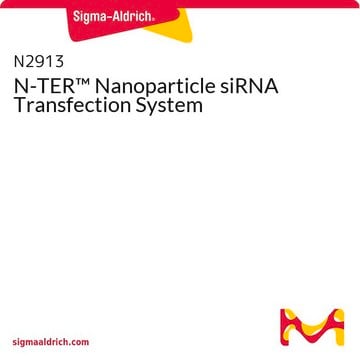XTG9-RO
Roche
X-tremeGENE™ 9 DNA Transfection Reagent
Polymer reagent for transfecting common cell lines
Sign Into View Organizational & Contract Pricing
All Photos(6)
About This Item
UNSPSC Code:
41106502
NACRES:
NA.55
Recommended Products
grade
for molecular biology
Quality Level
form
liquid (aqueous solution)
usage
mL (suitable for 165 transfections)
packaging
pkg of 0.4 mL (06365779001)
pkg of 1.0 mL (06365787001)
pkg of 5 × 1.0 mL (06365809001)
manufacturer/tradename
Roche
technique(s)
transfection: suitable
storage temp.
2-8°C
Related Categories
General description
X-tremeGENE 9 DNA Transfection Reagent is a proprietary blend of lipids and other components supplied in 80% ethanol, filtered through 0.2 μm pore size membrane, and packaged in glass vials.
Application
X-tremeGENE™ 9 DNA Transfection Reagent is a non-liposomal multi-component reagent for experiments involving cellular analysis. Due to its extremely low cytotoxicity, minimal need for optimization, and the ability to provide high transfection efficiency in a wide range of commonly used cell lines even in the presence of serum, it is well suited for applications in all fields of cellular analysis.
X-tremeGENE™ 9 DNA Transfection Reagent is well suited for cellular analysis applications such as:
X-tremeGENE™ 9 DNA Transfection Reagent is well suited for cellular analysis applications such as:
- Expression of recombinant proteins for functional analysis.
- Physiological studies of metabolic pathways.
- Analysis of regulatory sequences using reporter gene assays.
- Gene expression assays.
- Cancer research studies.
- Target evaluation.
Features and Benefits
- Generate physiologically relevant results using a reagent with extremely low cytotoxicity for maximum post-transfection cell viability.
- Save time and eliminate multiple handling steps; simply dilute X-tremeGENE 9 DNA Transfection Reagent, incubate with plasmid DNA, and pipet the mixture directly onto your cells (with or without serum).
- Avoid time-consuming optimization procedures in commonly used cell lines.
Quality
Each lot of X-tremeGENE™ 9 DNA Transfection Reagent is carefully tested following established quality procedures to ensure that the product is consistently performing according to specifications. During quality testing, cells are transfected with a reporter gene vector DNA using X-tremeGENE™ 9 DNA Transfection Reagent (ratio 3:1 μl/μg DNA). Reporter gene activity is monitored via chemiluminescent detection. Using a standard curve, the total amount of recombinant protein is determined per well in order to meet specification.
Physical form
Supplied in 80% ethanol and sterile-filtered through 0.2 μm pore size membrane.Number of Tests: Using the standard procedure, 1 ml of X-tremeGENE 9 DNA Transfection Reagent can be used to perform up to 6,600 transfections in 96-well plates using 3:1 ratio and up to 10,000 transfections using 2:1 ratio.
Other Notes
For life science research only. Not for use in diagnostic procedures.
Legal Information
X-tremeGENE is a trademark of Roche
related product
Product No.
Description
Pricing
Signal Word
Danger
Hazard Statements
Precautionary Statements
Hazard Classifications
Eye Irrit. 2 - Flam. Liq. 2
Storage Class Code
3 - Flammable liquids
WGK
WGK 1
Flash Point(F)
334.4 °F
Flash Point(C)
168 °C
Certificates of Analysis (COA)
Search for Certificates of Analysis (COA) by entering the products Lot/Batch Number. Lot and Batch Numbers can be found on a product’s label following the words ‘Lot’ or ‘Batch’.
Already Own This Product?
Find documentation for the products that you have recently purchased in the Document Library.
Customers Also Viewed
L C Costantini et al.
Neuroscience, 89(2), 505-513 (1999-03-17)
To investigate the role of neurotrophins in the initial formation of striatal patch versus matrix, the spatial and temporal expression of trkB receptors was examined using immunohistochemistry. Polyclonal antibodies, against the C-terminus or the tyrosine kinase domain, revealed trkB-immunoreactive cells
Leonardo Freire-de-Lima et al.
Proceedings of the National Academy of Sciences of the United States of America, 108(43), 17690-17695 (2011-10-19)
The process termed "epithelial-mesenchymal transition" (EMT) was originally discovered in ontogenic development, and has been shown to be one of the key steps in tumor cell progression and metastasis. Recently, we showed that the expression of some glycosphingolipids (GSLs) is
Piroon Jenjaroenpun et al.
BMC genomics, 10 Suppl 3, S9-S9 (2010-01-09)
DNA triplexes can naturally occur, co-localize and interact with many other regulatory DNA elements (e.g. G-quadruplex (G4) DNA motifs), specific DNA-binding proteins (e.g. transcription factors (TFs)), and micro-RNA (miRNA) precursors. Specific genome localizations of triplex target DNA sites (TTSs) may
Daniel F Comiskey et al.
Nucleic acids research, 43(8), 4202-4218 (2015-04-08)
Genotoxic stress induces alternative splicing of the oncogene MDM2 generating MDM2-ALT1, an isoform attributed with tumorigenic properties. However, the mechanisms underlying this event remain unclear. Here we explore MDM2 splicing regulation by utilizing a novel minigene that mimics endogenous MDM2
Jean Guillon et al.
Journal of enzyme inhibition and medicinal chemistry, 18(2), 147-153 (2003-08-29)
The syntthesis of new N-propargyl-3-pyrrol-1-ylindanamine derivatives, analogues of rasagiline, is described in ten steps starting from the corresponding arylaldehydes via the corresponding cis-3-pyrrol-1-ylindanamines. The cis-configuration of some intermediates has been established using X-ray analysis and NOE experiments. The new N-propargyl-3-pyrrol-1-ylindanamine
Our team of scientists has experience in all areas of research including Life Science, Material Science, Chemical Synthesis, Chromatography, Analytical and many others.
Contact Technical Service














